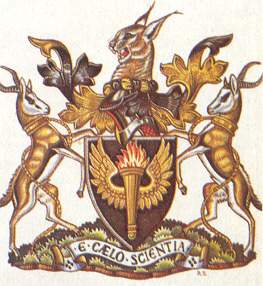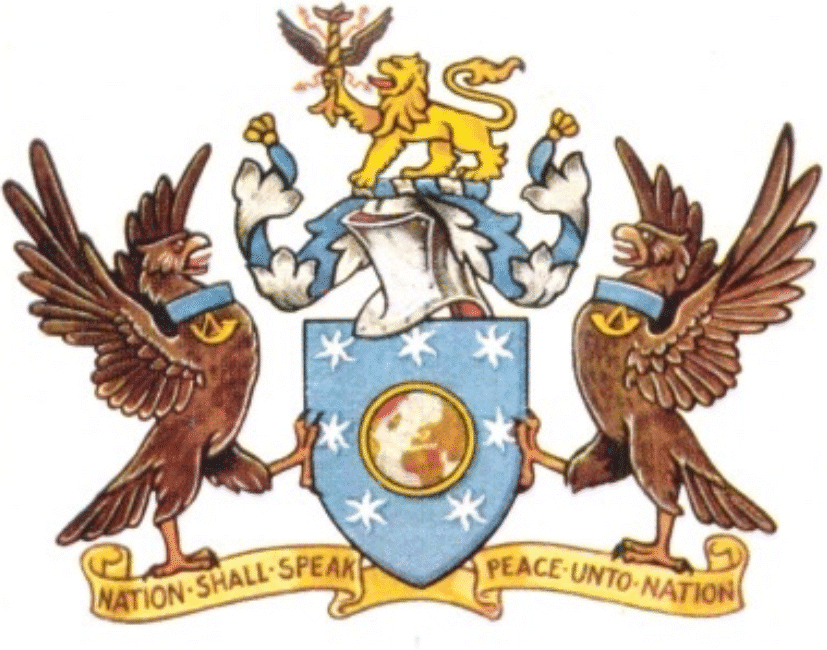

SA Broadcasting Corporation
by
Mike Oettle

Arms granted by the College of Arms under letters patent dated 22 April 1958 and registered by the Bureau of Heraldry under a certificate issued in Afrikaans on 8 June 1966. The blazon reads:
Arms: Sable, a winged torch Or with flame Gules.
Crest: A South African lynx, head and neck proper.
Mantling: Or and Sable.
Supporters: Two Springbok proper collared and
roped Or.
Motto: E CAELO SCIENTIA.
The torch symbolises the corporation’s function in spreading information, while the crest animal, a caracal (Felis caracal), also known as a lynx[1] or rooikat, with its finely shaped ears, resembling antennæ, indicates that it also pays close attention to events in the country and around the world.
The blazon as quoted (taken from the National Archives website, and probably originating in the deed of grant from London) is misleading, since it does not clearly state that only the cat’s head and ears form the crest. The reference to a “South African lynx” is unscientific, since the caracal ranges across Africa and into Asia: although it does not occur in deserts or rain forests, it is found from Cape Agulhas to the Mediterranean, in the Fertile Crescent and the coasts of Arabia, and as far inland as (formerly Soviet) Central Asia.
On the other hand the name Felis caracal uses the terminology of an era that predates DNA testing. Recent research indicates that there may be as many as four different caracal species, and that it is a genus distinct from Felis.
The supporters, a pair of springbok (Antidorcas marsupialis), are the national animal. Their collars and ropes indicate that they are inspanned in the service of the nation.
The arms are no longer in use, and the corporation now uses a variety of logos for its various television and radio stations. Television is an innovation since the arms were taken into use, since the first pilot broadcasts (in colour) took place in 1975, and a full TV service was inaugurated only in ’76.
About broadcasting in South Africa and the SABC:
Radio broadcasting in South Africa had its beginnings late in 1923 when concerts were broadcast from Johannesburg under the auspices of the broadcasting committee of the South African Railways.
The first regular broadcasts from Johannesburg began on 1 July 1924, undertaken by the Associated Scientific and Technical Associations of South Africa, or the AS&T Broadcasting Company. Cape Town followed suit on 15 September when the Cape Peninsula Publicity Broadcasting Association Ltd began broadcasting. In Durban the city corporation took up the challenge on 10 December, so becoming the first municipality in the world to have its own radio station.
N J Naudé writes:[2] “In 1934 the Prime Minister, Gen Hertzog, invited the Director-General of the British Broadcasting Corporation,[3] Sir John Reith (later Lord Reith), to visit the Union and advise on the future of broadcasting in South Africa. Having made a thorough study of the situation, he recommended that a public utility corporation be formed to take over broadcasting, on the termination of the Schlesinger concession, and conduct it in the interests of the country as a whole.
“The South African Broadcasting Corporation (SABC) was accordingly set up in terms of the Broadcasting Act (No 22 of 1936) and was inaugurated on 1 August 1936, taking over from Schlesinger.”
While in its early days the corporation set a standard of impartiality closely modelled on the service provided by the BBC, it gradually became a tool of the National Party government which came to power in 1948 on the policy platform of apartheid.
When the NP finally relinquished power following the 1994 general election, and more especially after it withdrew from the Government of National Unity established under President Nelson Mandela, the corporation fell into the hands of the African National Congress, which has displayed an even more rigorous bias in favour of its policies.
Language policy:
Whereas the earliest broadcasts were in English only, the SABC was established on a dual-language footing, with an English Service and an Afrikaans Service.
The first commercial service, Springbok Radio, was established on 1 May 1950 on the basis of bilingualism, although in practice it was a largely English service with some Afrikaans programmes and a few where both languages were used.
Broadcasts in Bantu languages came slowly. The erection of FM (frequency modulation) towers across the country during the 1970s facilitated the expansion of the service, and eventually all 11 Bantu languages spoken in South Africa were used. They initially fell under the umbrella name Radio Bantu, but separate services were then established for each language.
Also in the 1970s the English and Afrikaans services were commercialised and Springbok fell away. Afrikaans became so dominant that all news reports were first translated into that language, then vetted by political officials. They were then re-translated into English, leading to some appalling errors. The Bantu-language services were also commercialised.
An important propaganda tool under the National Party, the SABC also broadcast to countries around the world in 10 languages.
The television service also gave priority to Afrikaans, with dramatic productions in that language receiving far more money than those in English. French and German series were dubbed into Afrikaans.
Under the ANC, Afrikaans has been relegated to a minor status in both radio and television, but although English predominates, it is frequently spoken very badly indeed.
Afrikaans presenters are even forbidden to mention the service’s Afrikaans name, abbreviated as SAUK, but must instead refer to the SABC (Ess Ah Bee See).

